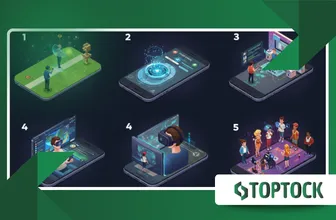5 Gaming Trends Changing Mobile Gameplay in 2025

The gaming trends changing mobile gameplay in 2025 are not mere upgrades—they’re fundamental shifts redefining how users play, engage, and connect.
Anúncios
From spatial computing to creator-integrated systems, the boundaries between game and reality are dissolving at an accelerated pace.
This article dives into:
- AI-driven personalization shaping real-time experiences
- Spatial computing integrating mobile games with physical space
- Monetization models shifting toward ethical, transparent practices
- Social mechanics driving longer engagement cycles
- Creator tools changing how users interact with content
The following breakdown helps decode these forces shaping the next frontier of mobile gameplay.
Adaptive AI Personalization: From Gameplay to Emotional Intelligence
AI is no longer confined to backend processes or enemy design logic. In 2025, it acts as a co-pilot to the player experience.
Anúncios
Games now collect real-time behavioral signals—like speed, hesitation, frequency of restarts, and even biometric data via sensors—to create adaptive environments that respond emotionally.
For instance, an open-world RPG can scale difficulty based on your decision-making style. If you’re a cautious explorer, the game might introduce strategic dilemmas instead of high-speed action.
Conversely, an aggressive player might experience denser enemy waves and timed events.
Neural engines in modern mobile SoCs like Qualcomm’s Snapdragon X Elite now support on-device learning, removing latency from cloud-dependent adaptation.
This enables ultra-personalized gameplay loops.
According to a Newzoo industry forecast, 42% of developers globally have now adopted adaptive AI systems into their mobile titles—a figure expected to exceed 60% by late 2025.
By treating gameplay as a conversation rather than a sequence, this AI revolution ensures no two player journeys are identical—boosting emotional investment and lifetime value.
Spatial Computing: Bridging the Virtual and Physical Worlds

Spatial computing is arguably the most visually striking of the gaming trends changing mobile gameplay.
It uses 3D environment mapping and advanced sensors to embed gameplay into the user’s real-world surroundings.
With LiDAR and ARCore/ARKit 2.0 advancements, smartphones can now create spatial anchors in seconds.
These allow for persistent, shared game elements that return to the same physical position every time the player reopens the app.
A location-based mystery game could, for example, place a digital safe on your office desk. The next time you enter that space, your mission continues where it left off—no loading, no disconnection from context.
Developers are now treating physical surroundings as level components. One studio even experimented with sound-reactive AI NPCs that behave differently depending on background noise levels and light exposure.
This immersive depth not only enhances user satisfaction but also sets higher expectations across app categories.
+ Block Blast Adventure Master: Clear the Grid with Smart Moves and Fast Thinking
Monetization Reinvented: The Era of Transparency
Players in 2025 are savvy, vocal, and loyal only to studios that respect their intelligence.
After years of backlash against loot boxes and deceptive paywalls, developers are investing in fair, transparent monetization models.
Flat-fee pricing, rewarded ads based on consent, and modular content packs have largely replaced the “pay-to-win” ecosystem.
Battle passes and skill-based economies now dominate the top-grossing charts. Notably, Epic Games’ mobile revenue model for Fortnite—which avoids pay-to-play mechanics entirely—has influenced dozens of new entries in the market.
An illustrative example: the mobile game Echelon Drift launched with a one-time $6 purchase model and opted out of ads altogether.
Instead, it offered cosmetic skins that are entirely skill-earned or purchased with full transparency. Three months in, it had a higher player retention rate than any freemium racing game launched in 2024.
A recent SensorTower report noted that games using transparent monetization models enjoyed a 23% increase in average user spend compared to those that did not.
+ Next Pokémon Presents Set for July – Here’s What to Expect
Social Mechanics Driving Deepened Engagement
Social integration is no longer a bonus; it’s a baseline. Mobile games are now expected to offer multiplayer environments that feel like digital campfires, not just competition arenas.
Co-op gameplay, live chat, shared missions, and synchronous events have moved from high-tier RPGs to casual and puzzle games.
Word games, for example, are embedding voice collaboration features for team-based challenges.
Additionally, game developers are leveraging third-party platforms like Discord and Twitch to extend gameplay outside the app itself.
A real-world example is how Legends Arena integrates post-match highlights directly into players’ Instagram stories, turning gameplay into shareable narratives.
This is a part of broader behavioral economics—users invest more time and money in games where they feel socially embedded.
It taps into the FOMO (fear of missing out) effect while building loyalty through shared identity.
Social-driven retention is more than a tactic. It’s a strategic evolution of what gameplay means in the mobile space.
+ Pokémon Legends: Z-A Release Date, Preorder Details, Upgrade Packs, and Cover Art All Revealed
The Rise of Player-Creators: Content as a Core Loop
One of the most empowering gaming trends changing mobile gameplay is the seamless integration of creator tools within mobile titles.
Players aren’t just players anymore—they’re designers, storytellers, and broadcasters.
Modern mobile games now include in-game level editors, skin designers, soundtrack overlays, and monetizable content export options.
This creator-first strategy does more than extend engagement; it builds micro-economies.
A prime case is CraftNexus, a sandbox-style puzzle game where players can sell their custom level packs.
Within four months of its release, over 100,000 custom packs had been downloaded, 17% of which were paid.
As a result, studios are hiring creator liaisons—not community managers—to manage this two-way content flow.
And players are forming their own niche followings based solely on the originality of their in-game creations.
By elevating users to co-creators, mobile games are transitioning from products into platforms.
Sustainability and Game Design: The Ethical Layer Emerging
With energy efficiency and carbon tracking now front and center in app design, sustainable development is becoming a serious factor.
Lightweight codebases, server-side logic offloading, and dynamic texture loading are being prioritized to reduce battery drain and server loads.
This green shift isn’t just ethical. It directly impacts session time and retention. Games that overheat devices or drain battery rapidly are being rated lower across app stores, as platforms like Google Play and the App Store increasingly prioritize performance metrics linked to sustainability.
Ethical considerations now extend to digital wellbeing too. Many games include reminder settings, healthy session nudges, and transparency around time tracking—especially those targeting younger audiences.
Sustainability, once a CSR talking point, is now part of UX strategy. It’s a subtle but important addition to the gaming trends changing mobile gameplay today.
The Trends at a Glance
| Trend | Description | Industry Impact |
|---|---|---|
| AI Personalization | Behavior-adaptive gameplay and emotional mechanics | Higher retention, personalized narratives |
| Spatial Computing | Real-world interaction through sensors and AR | Increased immersion, dynamic level design |
| Ethical Monetization | Transparent, non-exploitative revenue models | Increased loyalty, reduced churn |
| Social Integration | Seamless multiplayer, voice and live collaboration | Deeper community bonds, longer sessions |
| Creator Empowerment | User-generated content and monetization | UGC economies, diversified engagement |
| Sustainable Design | Battery-efficient, green software design | Better app store performance, longer play time |
Final Thoughts: The Shift Is Psychological, Not Just Technological
If 2025 marks anything in gaming, it’s the full arrival of participatory design. Mobile games are no longer “played” in the traditional sense. They are experienced, built, shared, and continuously evolved.
From the subtle emotional touch of adaptive AI to the rich social immersion of multiplayer storytelling, the industry is becoming more human—and more intelligent.
These gaming trends changing mobile gameplay reflect a deeper cultural pivot: players are no longer customers. They’re collaborators.
Studios that understand this will lead. Those that don’t will fade under the weight of outdated assumptions.
Frequently Asked Questions (FAQ)
1. What are the main gaming trends changing mobile gameplay in 2025?
AI personalization, spatial computing, transparent monetization, social mechanics, creator empowerment, and sustainable design are leading the evolution.
2. Are these trends affecting all types of mobile games?
Yes, from casual puzzles to hardcore strategy titles, developers across genres are adopting these innovations to remain relevant and competitive.
3. How can developers prepare for this evolution?
By investing in AI systems, engaging community tools, and sustainable code practices, while ensuring monetization remains fair and value-based.
4. Do players benefit from ethical monetization?
Absolutely. Ethical models reduce burnout, increase trust, and ensure a balanced experience that respects both time and money.
5. Where can I follow these trends in real time?
Platforms like GamesIndustry.biz regularly publish updates and insights from the mobile development landscape.
Popular Now










